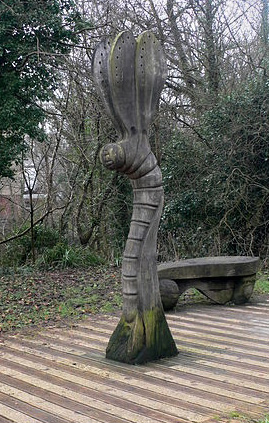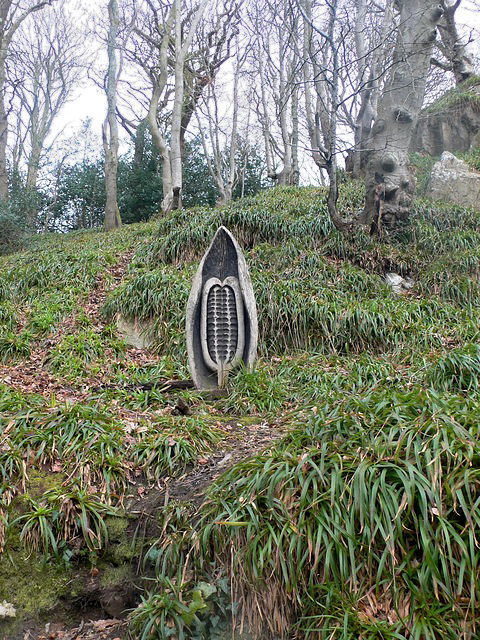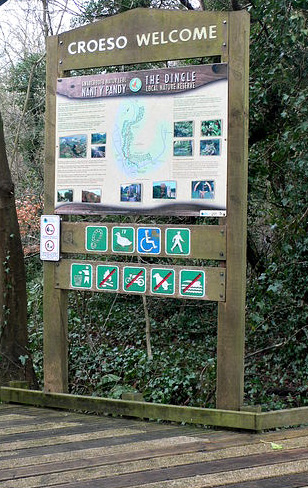Dingle Nature Reserve
aka Nant y Pandy Nature Reserve
Llangefni, Anglesey
|

Location Guide |
This 25 acre wooded valley is in Llangefni. It
is a steep sided gorge formed by glacial meltwater during the last ice age and
bisected by the River Cefni. Most of the reserve is ancient woodland, which is
where Dingle comes from as it means 'steep wooded valley'. It took on this name
in the 1830's. By some, locally, it is known as Nant y Pandy, "brook of the Fulling
Mill", this refers to the old wool processing plant situated upstream. Another
local name is Nant y Dilyw, meaning "Valley of the Deluge".

Bridge over the Cefni
 Photo by Keith
Williamson
Photo by Keith
Williamson

The Dingle extends from Cae Pandy (Pandy Field)
in the West to Pont Plas (Mansion Bridge in the East, with one of the oldest
sections of woodland on Anglesey, Coed Plas (Mansion Wood) extending eastwards
behind Llangefni Church. The part of the woodland in the Dingle is three
quarters of a mile long and three quarters of a mile wide and rises to 200ft
above sea level at its highest point.
Its ancient woodland is dominated by sessile
oak, ash and wild cherry, and is a carpet of
bluebells
 during
May. Other
parts are mainly sycamore and the occasional ash tree with an abundance of ferns
and mosses and woodland flowers, such as wood anemones. While Coed Plas, behind
the Church, was planted with sweet chestnut, beech and Scots pine, and
has a carpet of wild
daffodils during
May. Other
parts are mainly sycamore and the occasional ash tree with an abundance of ferns
and mosses and woodland flowers, such as wood anemones. While Coed Plas, behind
the Church, was planted with sweet chestnut, beech and Scots pine, and
has a carpet of wild
daffodils
 in spring.
Other flowers than can be found in the woodland during spring include primrose,
wood anemone and lesser celandine. in spring.
Other flowers than can be found in the woodland during spring include primrose,
wood anemone and lesser celandine.
There is a circular trail of 1.5 miles and
at a leisurely pace will take around an hour to complete. It starts and
finishes at the car park next to at St Cyngars Church in Langefni. There is
a
PDF guide
 which
details this and points out 12 significant spots along it. For the first 7
points a wooden boardwalk has been created winding its way along
the River Cefni, which allows access to this section of the reserve, at all
times of the year. There are also bridges which cross the river at various
points. For the occasional rest you could use one of the sculpted benches or
picnic tables. which
details this and points out 12 significant spots along it. For the first 7
points a wooden boardwalk has been created winding its way along
the River Cefni, which allows access to this section of the reserve, at all
times of the year. There are also bridges which cross the river at various
points. For the occasional rest you could use one of the sculpted benches or
picnic tables.
|

Dragonfly Sculpture
 Photo by
Eirian Evans
Photo by
Eirian Evans

There are also various sculptures
placed around the reserve and these include a huge dragonfly, giant seed pods and split oak
timbers revealing the poem Nant y Pandy, by local poet Rolant o Fôn.
Seed Pod Sculpture
 Photo by
Eirian Evans
Photo by
Eirian Evans
 |
 |
| Wildlife
It is home to a variety of wildlife which
can be seen throughout the year including:
In the woodland
- Blue Tits
- Great Tits
- Ravens
- Buzzards
-
Woodpeckers

- Adders
- Lizards
- Bats (8 out of 16 British species
can be seen here at dusk)
- Tawny Owl can be heard, and often
seen, in the woodland at night.
On the river
- Moorhen
- Dragonflies
- Damselflies
-
Herons

- Kingfisher
- Dipper
- Frogs
- Newts
On the Broadwalk
|

Dingle Entrance
 Photo by
Eirian Evans
Photo by
Eirian Evans
 |
Other wildlife includes:
Many butterfly species, such as
the Gatekeeper and
the Speckled Wood, as well as moths. There are also hoverflies, bees and wasps, beetles, slugs and
snails, spiders, woodlice,
and many other small creatures. Fish like trout, roach and perch may be seen in Llyn Pwmp, and sea
trout are occasional visitors, as are eels in the river. Mammals are much
more elusive but foxes are present as are Bank vole and wood mice who leave
signs of nibbled hazel nuts to show their presence. spiders, woodlice,
and many other small creatures. Fish like trout, roach and perch may be seen in Llyn Pwmp, and sea
trout are occasional visitors, as are eels in the river. Mammals are much
more elusive but foxes are present as are Bank vole and wood mice who leave
signs of nibbled hazel nuts to show their presence.

The Old Mill Pond
 Photo by
Stephen Roddick
Photo by
Stephen Roddick

|
Location: Dingle Nature Reserve, Llangefni,
Anglesey |
|
Grid Reference: SH456760 |
Ceremonial County:
Anglesey
 |
|
Map Link:
StreetMap

|
Aerial photo:
Google Aerial
 |
|
Getting there: From A55 take the exit for
Llangefni taking the A5114 into the town centre and follow the brown tourist
signs |
|
Access: The trail is suitable for
wheelchair users and is possible with pushchairs. There are two car parks on
the edge of the Dingle, one next to the church. |
Website:
www.anglesey.gov.uk/doc.asp?cat=1251
 |
Other Useful Websites:
PDF Guide to The Dingle   Visit Anglesey
Visit Anglesey
 Geograph
Geograph
 |
|
Email: |
|
Address: The Dingle Local Nature
Reserve, Llangefni, Anglesey |
|
Postcode: LL77 7QD |
Telephone: 01248 752428 |
|
Opening Times: All Year |
|
Charges: FREE but there may be parking charges
in the car parks. |
Nearby Locations:
Llangefni Windmill
  |
|
Other Location Pages: |
Other Relevant Pages:
Anglesey Attractions
 Anglesey
Attractions Map
Anglesey
Attractions Map
 |
|
Notes:
|
|

|
Please let us know any other information that we
can add to the Grid(s) or page and any errors that you discover. Before making a long trip to any location it is always
wise to double check the current information, websites like magazines may be
correct at the time the information is written, but things change and it is of
course impossible to double check all entries on a regular basis. If you have
any good photographs that you feel would improve the illustration of this page
then please let us have copies. In referring to this page it is helpful if you
quote both the Page Ref and Topic or Section references from the Grid below. To print the
planning grid select it then right click and print the selected area.
Please submit information on locations you discover so
that this system continues to grow.
|